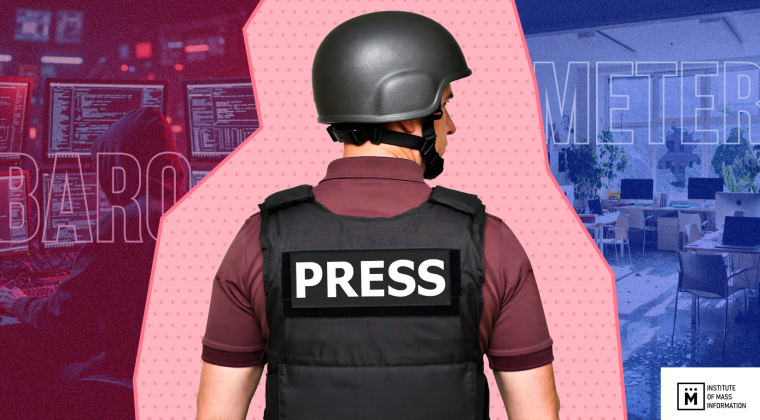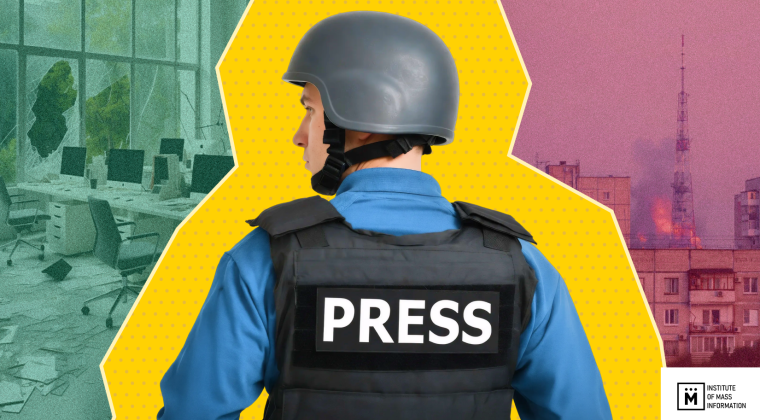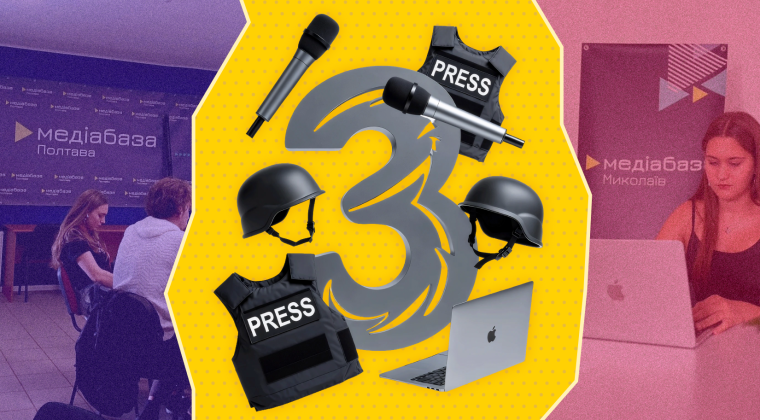On November 11, after eight months of Russian occupation, Kherson was under Ukraine’s control again, as well as Snihurivka (Mykolaiv oblast). For over a month, all of Ukraine and the world have been assessing the aftermath of occupation. In addition to destroying and looting property, torturing and abusing the locals, the Russians had been waging their information war during their entire stay in the occupied territories, distributing propaganda newspapers where they humiliated Ukrainians and justified the war by calling it “liberation from neo-Nazis” and distorting history in every possible way.
Thanks to their readers from the liberated territories, the SBU Office in Mykolaiv oblast, and subscribers of the “Mykolaiv Vanyok” Telegram channel, “NikVesti” were able to have a look at some issues of Russian newspapers. In total, they analyzed 15 newspapers distributed by the Russians in the occupied parts of Southern Ukraine between May and November. These included special issues of “Komsomolskaya Pravda”, “Boevaya Gazeta”, “Naddnepryanskaya Pravda”, and “Nasha Kakhovka”.
“Komsomolskaya Pravda” is a Russian propaganda newspaper owned by chairman of the Baltic Media Group, Sergei Rudnov – the son and heir to Russian President Vladimir Putin’s close friend. KP has been called the Russian President’s favorite newspaper. The former editor-in-chief of the newspaper, Vladimir Sungorkin (died in September 2022), used to be Putin’s confidant before the 2018 presidential elections.
Interestingly, the newspaper’s special editions published after the propagandist’s death keep listing him as the editor-in-chief and general director of the “Komsomolska Pravda” publishing house. The publication issued a separate special issue for each occupied region: “Kherson”, “Zaporizhzhia Oblast”, “Liberated Territories”.
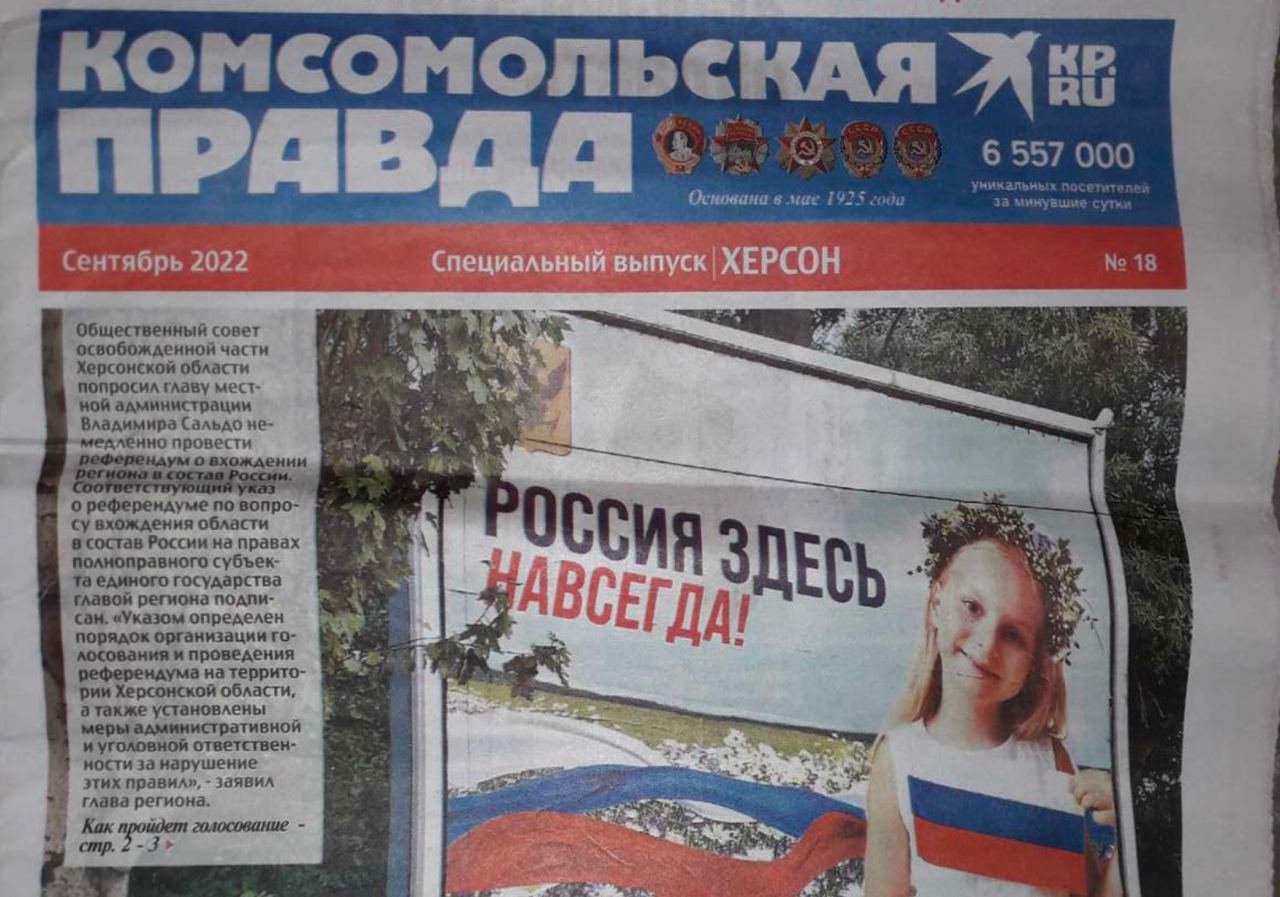
“Boevaya Gazeta”. The newspaper says that it is published with the support of “the patriotic public and the Bolshaya Strana Foundation.” The newspaper is prepared for print by “Boevaya Gazeta Editorial Board” and the “Komsomolska Pravda” publishing house. The listed print run ranges from 50 to 150 thousand copies. According to open source data, the autonomous non-profit organization “Boevaya Gazeta Editorial Board” was founded in March 2022 in Moscow. The director is Yan Edvaldovich Pehkonen.
Talking about “Boevaya Gazeta’s” first issue, dated May 9, 2022, “Komsomolskaya Pravda“, openly claimed that the newspaper’s correspondents would “fight” on the front line together with the military and spread Russian propaganda – “exposing the lies of Ukrainian, British, and American provocateurs.”
“The newspaper will ‘fight’ in the same ranks as those who are taking us towards Victory,” the publication wrote.
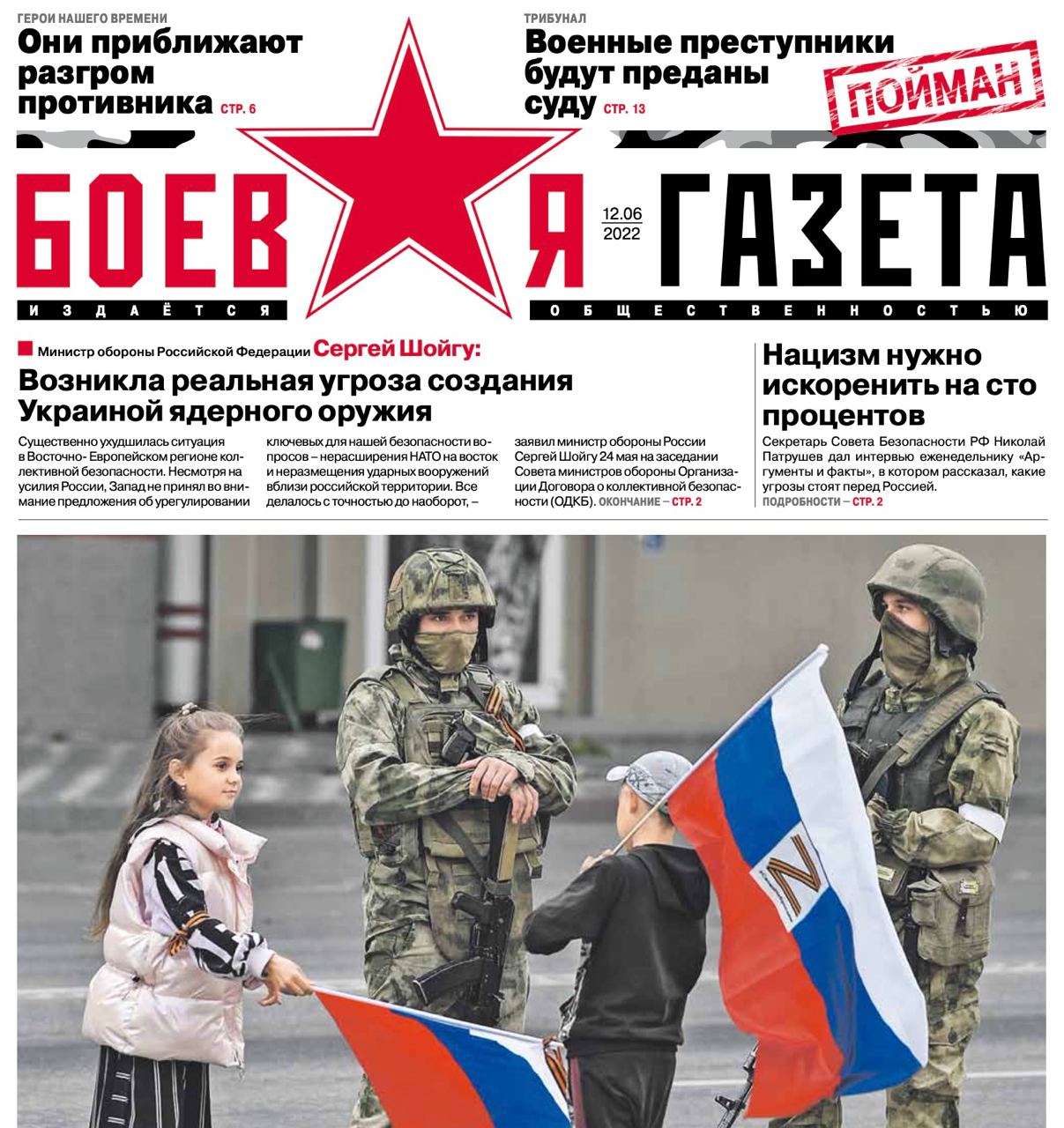
In June, the Russians started issuing a newspaper called “Naddnepryanskaya Pravda” in the occupied Kherson oblast. The newspaper’s first issue featured deputy head of Kherson’s occupation administration, Gauleiter Kyrylo Stremousov (killed by a Russian attack from the right bank of the Dnipro river on November 9, 2022), noting that it was founded in 1928, has been “languishing miserably” through the years of Ukraine’s independence, and is now being revived “so that people know the truth about what is happening now in the land of Kherson oblast.”
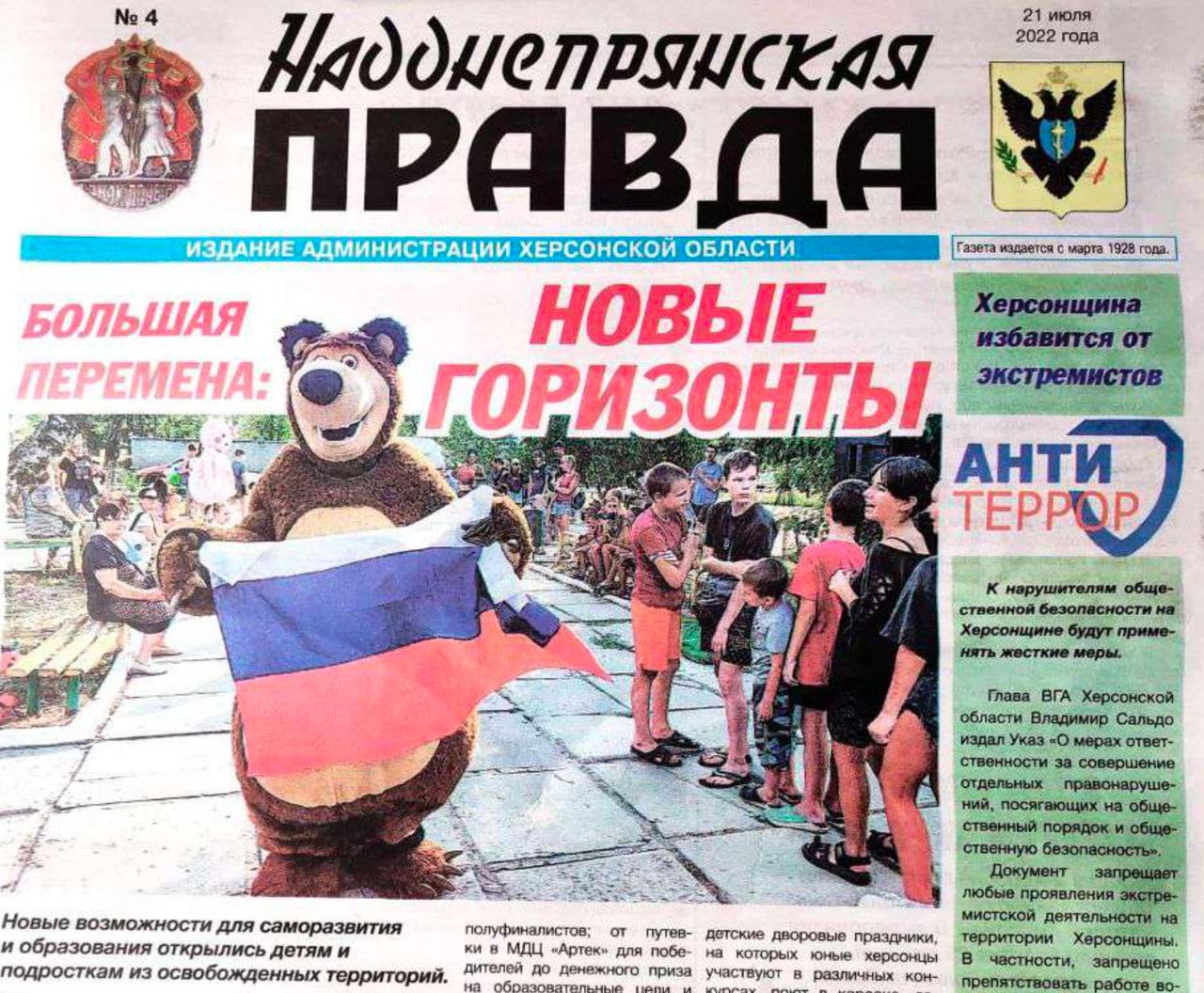
Furthermore, the occupation authorities of Kakhovka created their own printed publication “Nasha Kakhovka”. The first issue of the newspaper is dated August 2, 2022, and was dedicated to the anniversary of the Christianization of Kyivan Rus. The propaganda newspaper released 12 issues in four months; all of them are available on the “Nasha Kakhovka” Telegram channel. The latest issue is dated November 2, 2022. The newspaper had a print run of up to 15,000 copies. The source data says that the newspaper was being printed by the “Reklama plus” printing house at 15/2 Universitetska Street, Melitopol, Zaporizhzhia oblast. According to YouControl, that address used to belong to the “Forwardpress” printing house, owned by Artur Volodymyrovych Dubina.
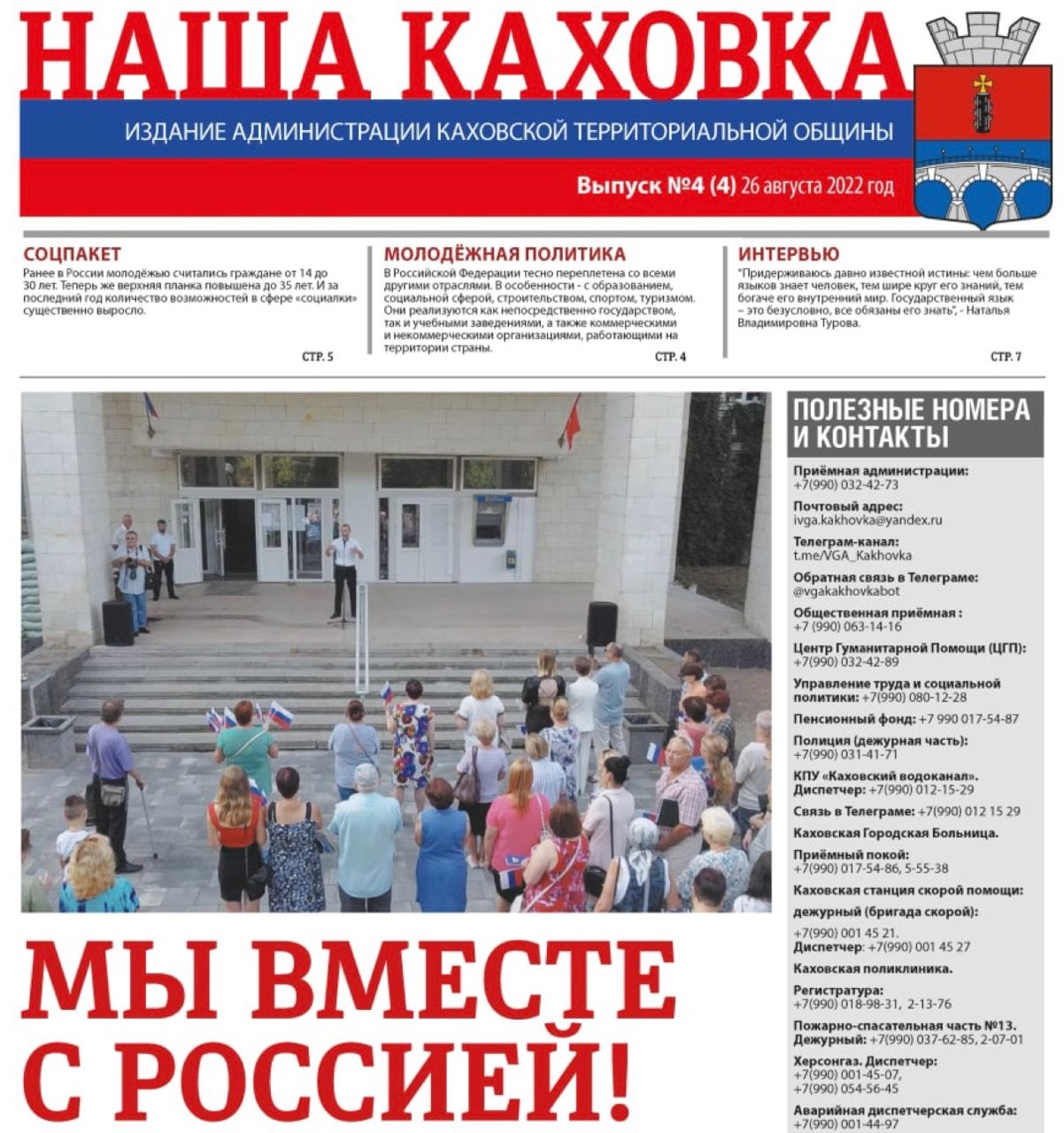
None of the mentioned newspapers provide any information on the authors of the articles or the editor.
Moreover, in Snihurivka, the occupiers even printed a clone of the regional newspaper “Ridne Prybuzhzhia”, translating the name into Russian – “Rodnoe Prybuzhye” – and using the signature typeface of the printed publication that is well-known and influential in the oblast.

One can trace several specific narratives promoted by Russian propaganda: namely, about Ukraine having fallen under the rule of Nazis, and about the Russian occupation of parts of a sovereign state’s territory being, in fact, an act of reclaiming Russia’s historical land and returning it to the Russian family. Another narrative is that the war Putin is waging in Ukraine is actually with NATO, not with the Ukrainian people.
“Truth is with us, Russia is with us” – such a headline can be seen on the cover of “Komsomolskaya Pravda’s” October 2022 special issue. The newspaper was celebrating the “accession” of the “DPR”, “LPR”, as well as Zaporizhzhia and Kherson oblasts to Russia.
Distorting history
On August 2, an article titled “One Country”, dedicated to the 1034th anniversary of the Christianization of Rus, was published in the “History” section of the occupiers’ newspaper “Nasha Kakhovka”.
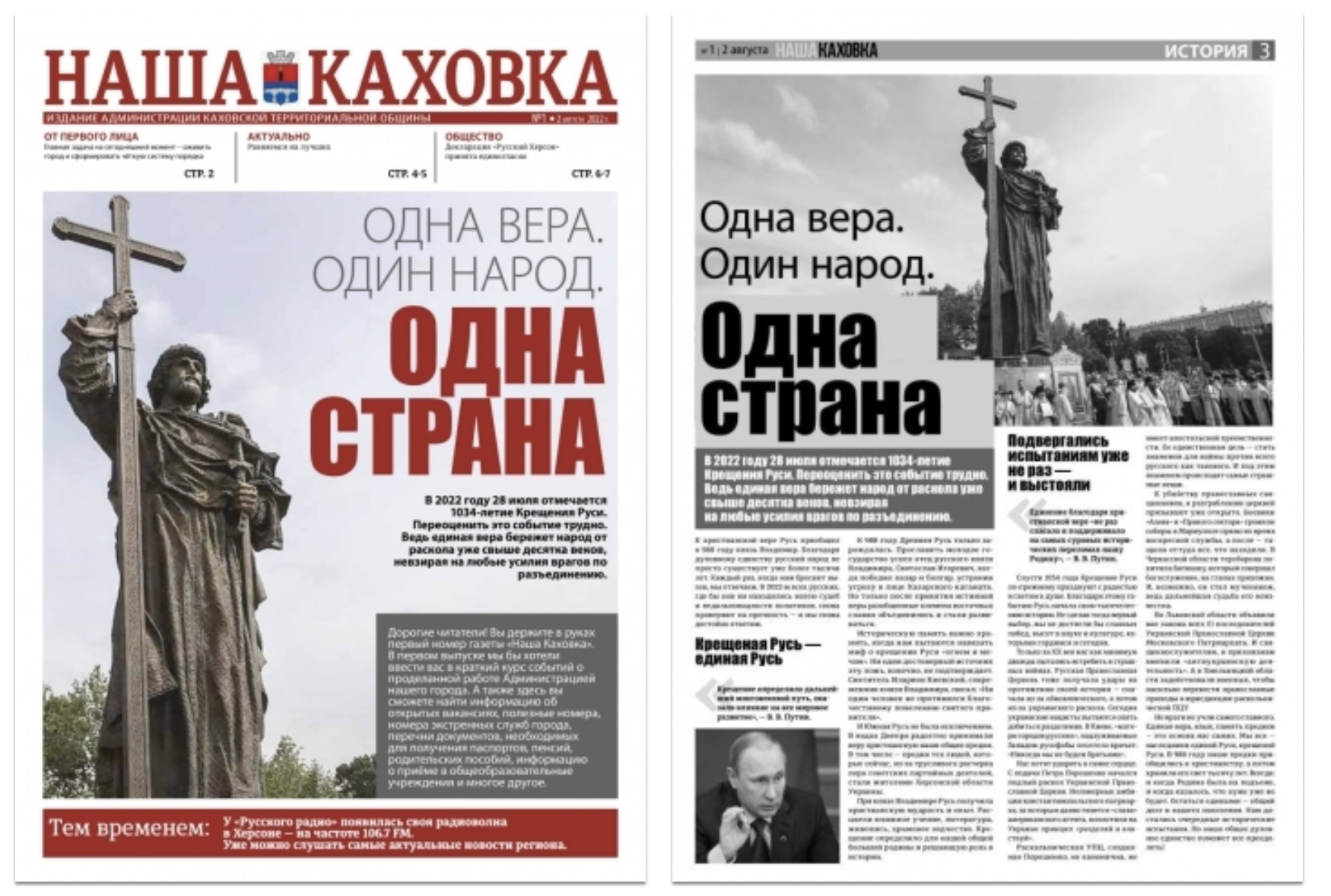
“NikVesti” reached out to history PhD, Professor Yuriy Kotlyar, who specializes in the history of Southern Ukraine and Ukraine’s military history. He analyzed the key points of the article where Russians exploit and distort historical facts.
1. “One faith. One people.” This slogan is either delusional or utterly expansionist. “Faith” refers to Orthodox Christianity. The Orthodox Church is the second largest Christian community in the world after the Roman Catholics. Orthodoxy is the most popular religion in Russia, Ukraine, Romania, Belarus, Greece, Serbia, Moldova, Georgia, Cyprus, Montenegro, and North Macedonia. As to the “one people” part, Belarusians may fit, but even that is up for debate. These nations do not quite fit into the concept of “one people” with Russians. Some of them are not even Slavic.
2. “In 988 AD, Ancient Rus was just emerging.” This thesis contradicts the historical reality. Even the Soviet chronology puts the emergence of Rus at 882 AD, although in fact it happened even earlier. But even if we take the aforementioned emergence date as true, over 100 years of difference is nonsense.
3. “… the father of Russian Prince Vladimir, Sviatoslav Igorevich.” What Russian prince? Volodymyr the Great, years of rule: 979–1015. Moscow, from which Muscovy (or Russia, as they interpret it) takes its beginning, will be founded in 1147, according to the Soviet myth, and in 1272, if we stick to a more realistic date. The name “Russian Empire” was only introduced in early 18th century, under Peter I. All the listed dates do not correlate with one another. And Volodymyr could not in any way have been a prince of a state that would emerge centuries after his death.
4. “Petro Poroshenko initiated the vile schism of the Ukrainian Orthodox Church.” The emergence of the Orthodox Church of Ukraine is a complex theological issue. In terms of politics, however, we can say that having one main religion makes a state stronger. The tomos on the autocephaly of the Orthodox Church of Ukraine was signed and received on January 5–6, 2019, in the St. George Cathedral, the cathedral of the Ecumenical Patriarchate. The tomos was not recognized by the Russian Orthodox Church, as this article shows.
“Thus, we have in front of us an utterly propagandistic article targeted towards people who do not possess basic knowledge of history,” says Yuriy Kotlyar.
The Russians also used their newspapers to spread fakes about Southern Ukraine rightfully belonging to Russia. Namely, in the Kherson special edition of “Komsomolskaya Pravda” dated September 22, 2022, they for some reason decided to congratulate Kherson city on its birthday, calling it “a city with a Russian destiny.”
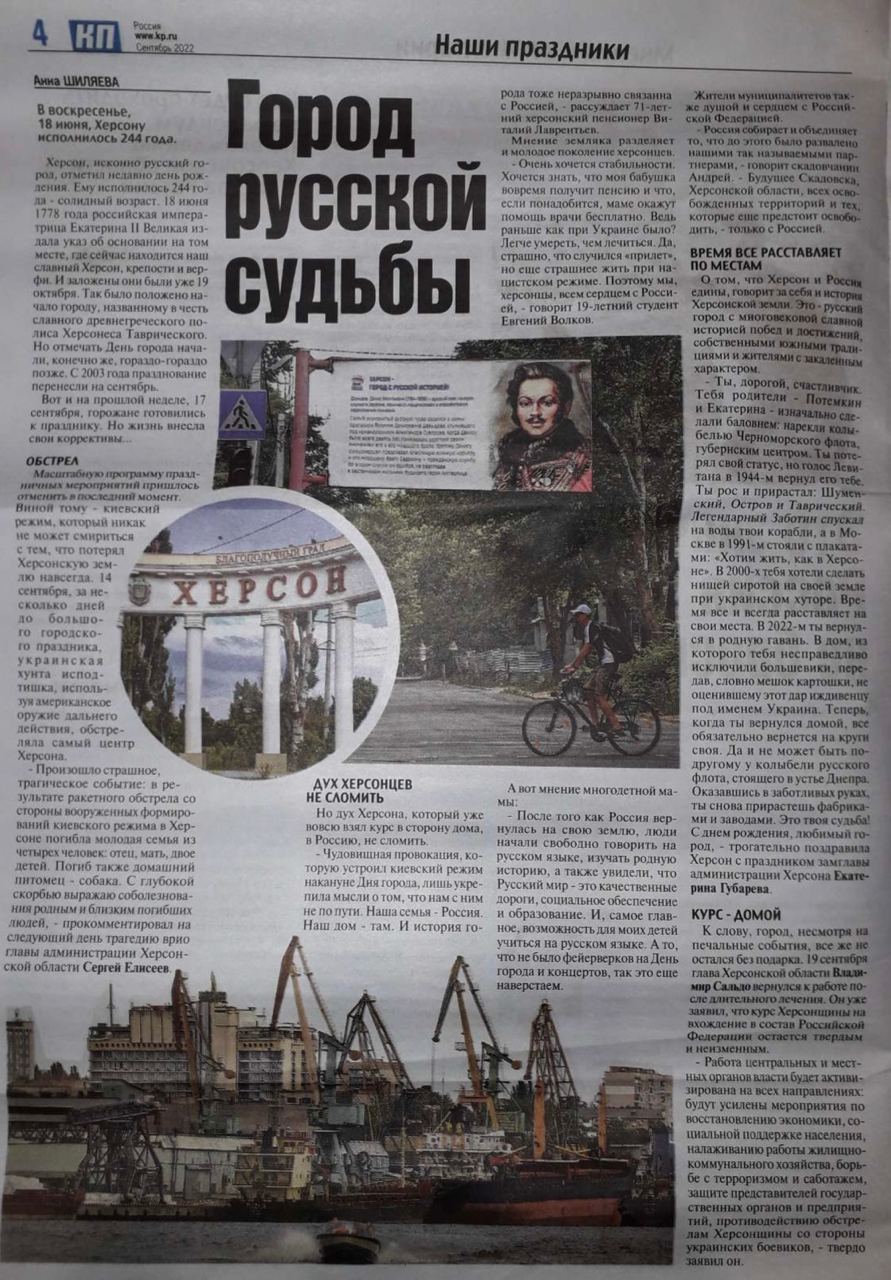
On September 30, 2022, “Boevaya Gazeta” published an article titled “The Country of Strong People”, which features a brief history of New Russia, written by famous Russian author and historian Alexandr Myasnikov.
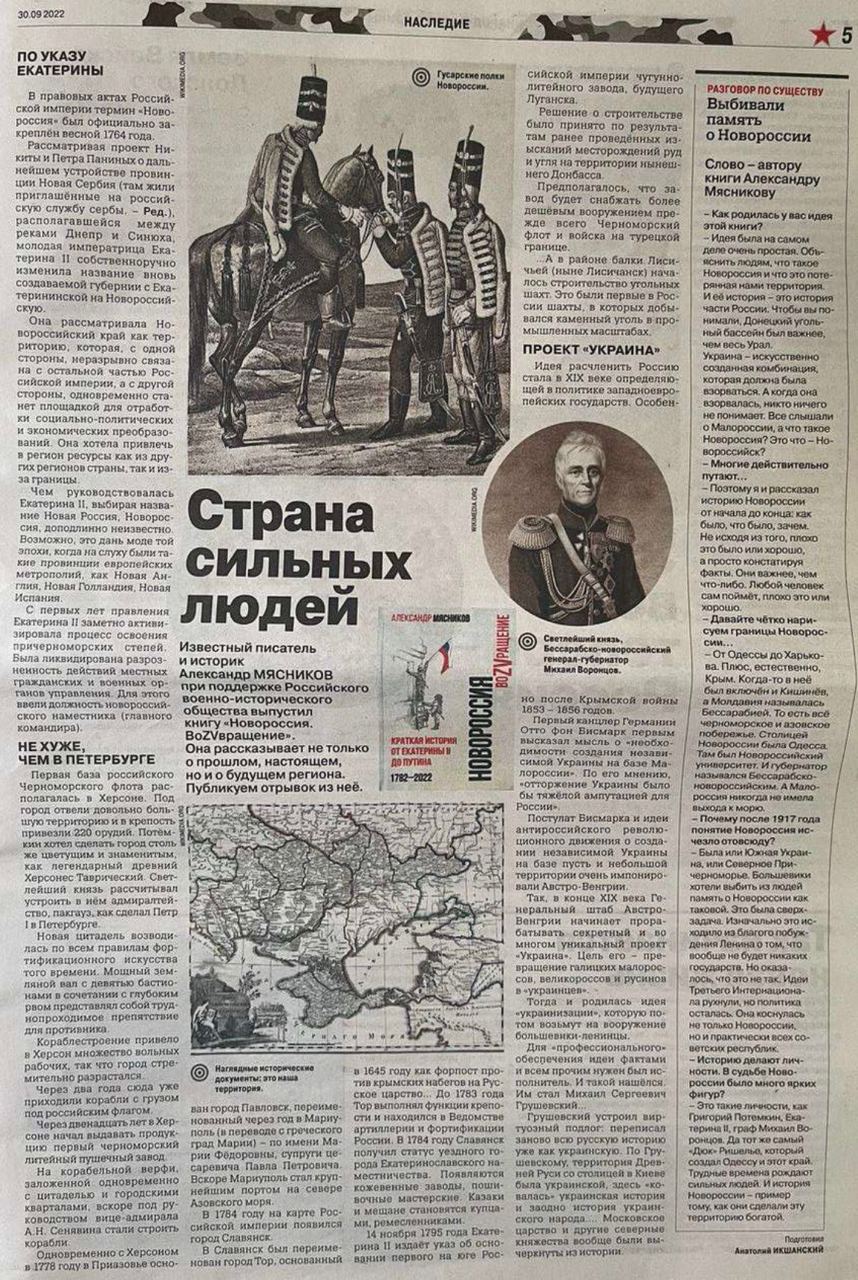
“It is unclear who these propaganda texts are for. In our country, this kind of cheap literature has been out of fashion for a very long time, even more so in Russia. Reading, analysis, and Russians are completely incompatible things,” Yuriy Kotlyar believes.
He noted that Ukrainian history studies have a clear answer regarding Russia’s “New Russia” project. In 2015, the Institute of Ukrainian History at the National Academy of Ukraine published a book by history professors Fedor Turchenko and Halyna Turchenko, titled “Project ‘New Russia’ and the latest Russian–Ukrainian war“, where they dotted all the i’s on this matter. The authors study the circumstances under which the Russian imperial project “New Russia” emerged in 1764 and the attempts to implement it by the tsarist regime, the Provisional Government of 1917, the Soviets, and modern Russia. The 250 year evolution of the Ukrainian–Russian relations can be traced through this project. The book provides historical facts, statistics, and maps, and outlines the peculiarities and common features of the different Russian regimes’ policies with regards to Ukraine. Much attention is paid to the Soviet and modern Russian regimes’ policy in the South and East of Ukraine, as well as the origins and distinct features of the latest Russian–Ukrainian war.
“The most important conclusion drawn by the authors is that ‘the fate of Ukraine, including its southern and eastern regions, will be determined by its citizens, the vast majority of whom, regardless of their ethnic background, resolutely reject the imperial project ‘New Russia’ and perceive the Donbas, the South, and Crimea as integral parts of Ukraine – their shared Motherland.’ Thus, the publications which try to prove that Kherson and the South of Ukraine are Russian, contradict known historical facts and are propaganda,” the historian noted.
The special role the occupiers alot to the “Russian history” of the South of Ukraine is also evidenced by the propagandists’ attention to historical monuments, which the Russians fist heroically “restored”, and then stole while fleeing from Kherson.
In Snigurivka, Russians were distributing a clone of regionally popular newspaper “Ridne Prybuzhzhia”

On December 7, the SBU Office reported the detention of former Snigurivka Mayor Oleksandr Larchenko, who had been the “deputy head” of the city’s occupation administration. “In the course of authorized searches at the involved person’s home, evidence of his criminal activities, namely a copy of a voluntary cooperation order, pro-Russian periodicals, leaflets with instructions on acquiring Russian citizenship, have been discovered and seized,” the SBU said in a statement.
On their official Facebook page, the Mykolaiv Office of the SBU posted a photo of the newspaper “Rodnoe Prybuzhye”, whose design resembles the Mykolaiv regional newspaper “Ridne Prybuzhzhia”.
Pictured: one of the last editions of “Ridne Prybuzhzhia”, published on the eve of the full-scale war.
The newspaper “Ridne Prybuzhzhia” was founded in 1991 as Mykolaiv oblast’s official printed publication. In 2019, the newspaper has been denationalized, and is currently a private enterprise headed by editor-in-chief Tetyana Fabrykova. Before the start of the full-scale war, the newspaper used to print three issues a week with a print run of about 10,000 copies and was distributed throughout Mykolaiv oblast.
Editor-in-chief Tetyana Fabrykova told NikVesti that the newspaper’s last issue had been published on February 24, 2022; after that, it had to suspend its operation due to the hostilities. As of December, the publication has not resumed its work because of financial difficulties, the energy situation in Ukraine, and the journalists being physically absent from Mykolaiv, which remains a front-line city in the full-scale invasion. Tetyana Fabrykova is outraged by the fact that the Russians created a clone of “Ridne Prybuzhzhia” in order to exploit the newspaper’s reputation to promote pro-Russian propaganda among the residents of Mykolaiv oblast.
She said that “Ridne Prybuzhzhya” had been printed in Kherson for the last few years. Tetyana Fabrykova believes that the occupiers were able to gain access to the newspaper’s files stored in the printing house and used them to create the clone.
“I was not aware of this situation, I am outraged by the fact that they used our logo, that they would issue such a thing. When the hostilities started in Mykolaiv oblast, we stopped printing the newspaper, because, first, we were doing it in Kherson, the printing press was there… Mykolaiv newspapers are now gradually resuming their work, in particular ‘Yuzhnaya Pravda’ and ‘Vechirniy Mykolaiv’, but we are not prepared to release another issue yet, because our journalists are not in Mykolaiv yet. I think that as soon as our power grid is stabilized, we will of course resume our work. We will fulfill all our obligations to our subscribers. Because we are almost a year behind. We only fulfilled our obligations to subscribers for January – February. This issue that you discovered is a scam, they know that such a newspaper existed, so they made use of it,” said Tetyana Fabrykova.
The pro-Russian “Rodnoe Pribuzhye” (with the only issue dated September 23) was intented to promote a pseudo-referendum on the accession of Kherson oblast and Snigurivka, Mykolayiv oblast, to Russia. The newspaper’s source data indicate that it was printed in Kherson oblast with a print run of 10,000 copies. There is no other information neither on the publication nor the person responsible for the issue.
This newspaper published an article titled “The Russian town of Snegurivka is coming back home”. The propaganda article justifies the occupation of Snigurivka (Mykolaiv oblast) by the fact that 200 years ago, the Russian Empire sent people from the village of the same name, Snigurivka (Smolensk region), here, which is why the residents of Snigurivka seem to feel a connection to Russia over generations.

Historian Yuriy Kotlyar commented on this article:
“As a Ukrainian, it outraged me, and as a historian, it merely amused me. Because I haven’t read this kind of fantasy fiction in a long time. So let us begin. In 1812, the state serfs of the Klymovytsky district, Mogilev province, moved to the state-owned land on the right bank of the Ingulets river. What does Russia have to do with it, when the settlers were mainly Belarusians, and the Mogilev province itself was only created in 1772, after the first division of the Polish-Lithuanian Commonwealth, from a part of the Belarusian land. Therefore, Snigurivka was effectively inhabited by former residents of the Polish-Lithuanian Commonwealth. And here are some fascinating facts about the “Russian” city of Smolensk, featured so extensively in this article. Smolensk is an ancient Slavic city, founded by the Kryvych tribe. In 882, the city was captured and annexed into Kievan Rus by Prince Oleh, who handed it over to Prince Ihor, and the general ruling was carried out from Kyiv. Since 1404, Smolensk, together with other Ukrainian lands, was part of the Grand Duchy of Lithuania. In the Battle of Grunwald in 1410, the Smolensk regiments were fighting for the PLC. In 1514, Smolensk became part of the Muscovite state, but in 1609–1611, the Polish-Lithuanian Commonwealth troops won it back. And only after the Andrusiv Peace Treaty (1667) Smolensk became part of the Moscow Empire. Thus, Smolensk and Mogilev province have a historical connection to Kievan Rus, the Grand Duchy of Lithuania, the Polish-Lithuanian Commonwealth, and only then, after being conquered, to the aggressor state – the Moscow Tsardom. Snigurivka is Ukraine, and it was founded by immigrants from Belarusian districts. It has nothing to do with Russia,” said Yuriy Kotlyar.
The Russian-forged “Rodnoe Prybuzhye” also published a fake about the head of the Mykolaiv Regional Military Administration, Vitaliy Kim, “fleeing” the region (albeit not far, as it turned out, – to Odesa). The newspaper cited the pro-Kremlin media RIA Novosti. The article also featured an utterly pathetic comment by an “expert” – Oleksiy Zhuravko, a former Ukrainian politician, a former People’s Deputy from the “Party of Regions”. In 2015, he fled to Russia, and came back to Kherson in April 2022, where he died on September 25, two days after the newspaper was published.
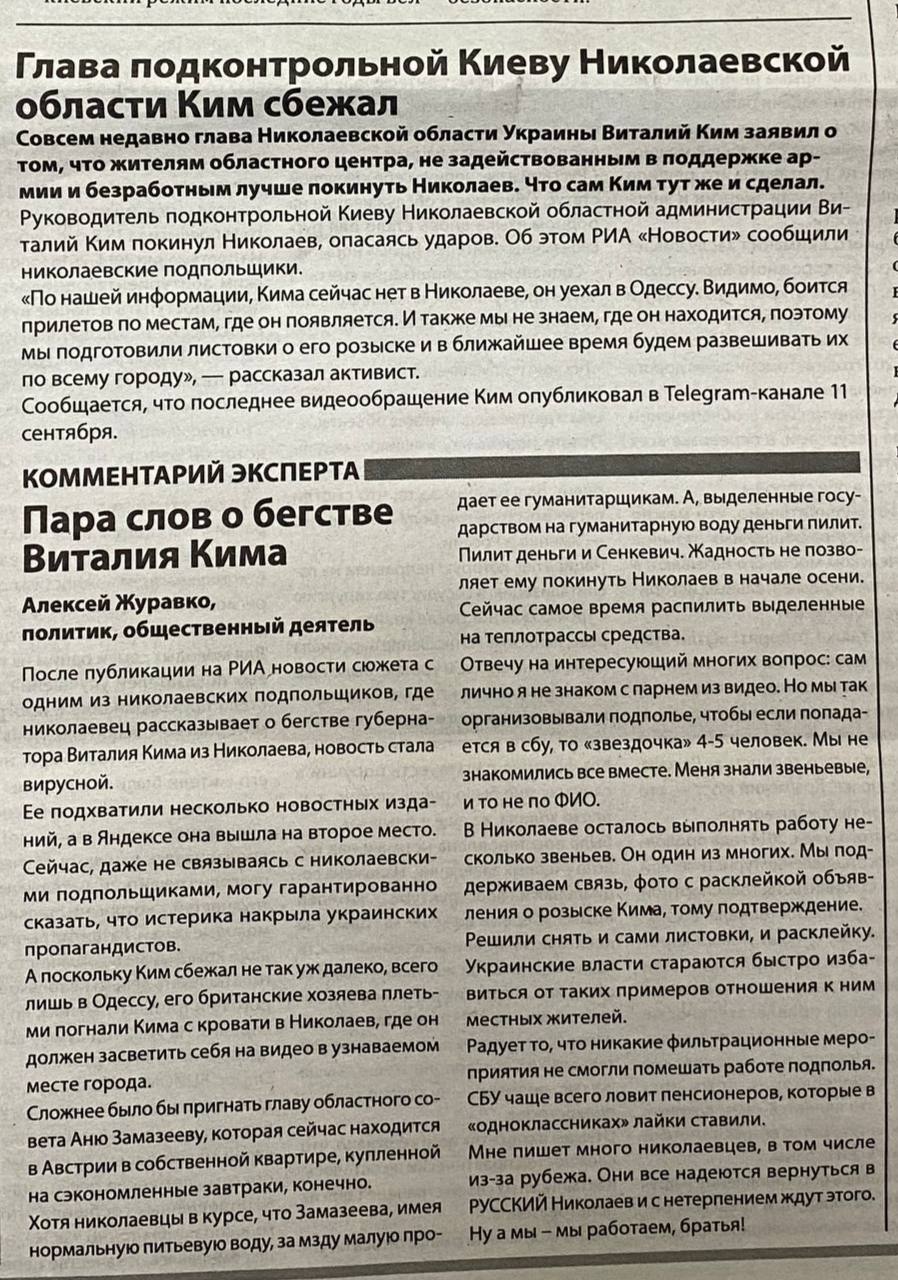
Propaganda posing as “independent” journalism
On August 18, 2022, “Naddnepryanskaya Pravda” published an article titled “A step has already been taken, we must move on.” The article is an interview with “Turkish journalist, political scientist, author, and public figure” Okay Deprem. The article notes that the “journalist” has written a large number of publications about Ukraine, Russia and the Donbas conflict. He used to be a contributor at the socialist newspaper ‘Evrensel’, which is published in Turkey and some European countries. Now Okay works with the Turkish TV channel Tele1, which actively quotes Russian propaganda.
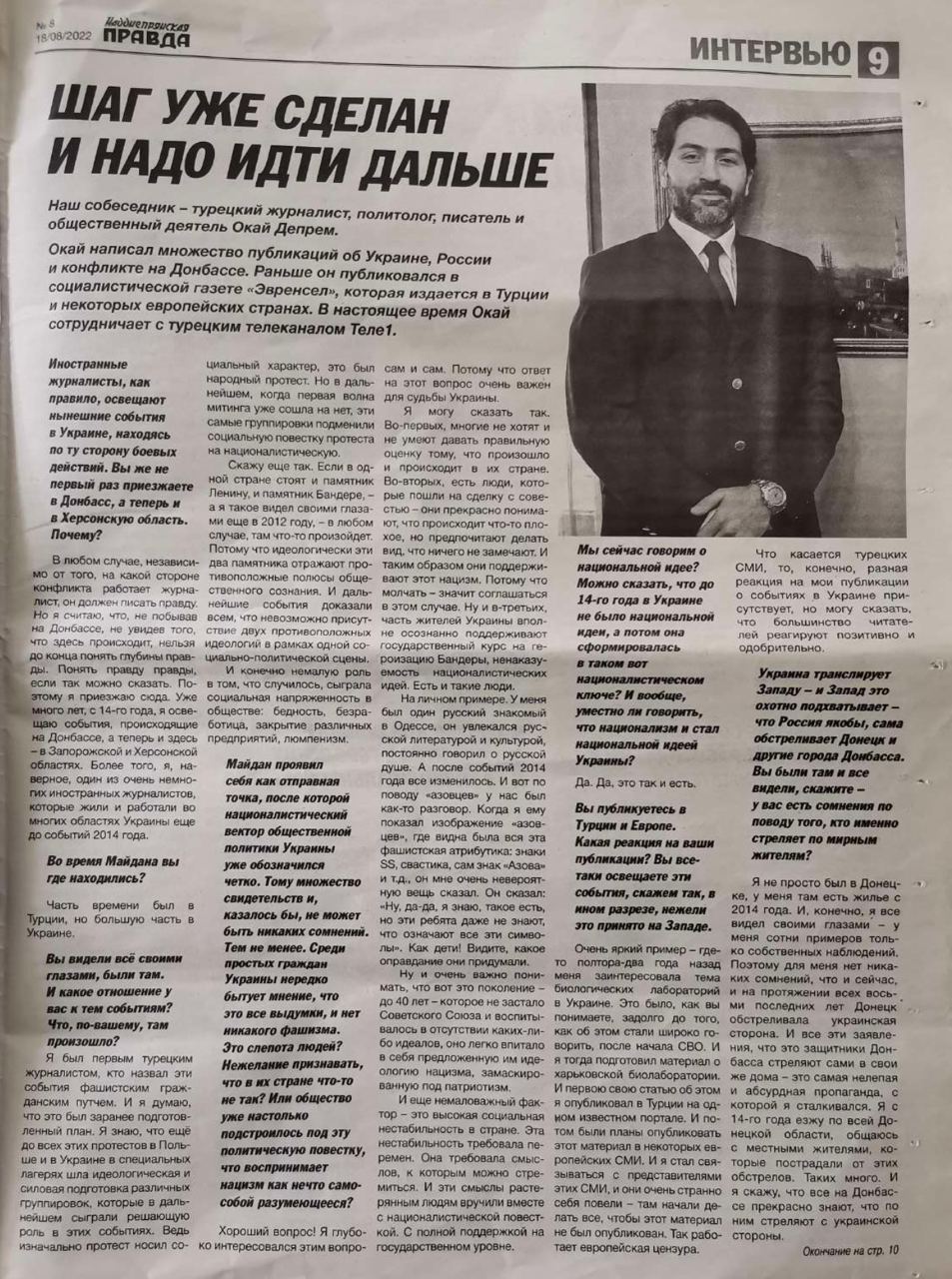
In his interview to the occupation administration’s newsaper, Okay Deprem reflected on journalistic standards, independent journalism, and journalists who “must write the truth.” Yet, Okay Deprem himself is not above biased value judgments which go against journalistic standards, such as calling the 2013–2014 Revolution of Dignity in Ukraine a “fascist civil putsch.”
In the article, the “journalist” condemns the “glorification of Bandera” and talks about the mythical Ukrainian biolaboratories, the existence of which has been refuted in the world many times over. Ukrainian Ministries, as well as the governments of ten countries published a joint statement on this matter in August. In the document, the United States, Armenia, Georgia, Iraq, Jordan, Liberia, the Philippines, Sierra Leone, Uganda, and Ukraine refuted the Kremlin’s disinformation narratives regarding the biological weapons purportedly developed in the so-called “secret laboratories.”
It should be noted that the “biolaboratories” narrative was also promoted in one of the special issues of “Komsomolskaya Pravda” which were being distributed in the occupied territories. In particular, the “KP Investigation” section of the May 2022 issue contains an article titled “Why did the USA experiment with deadly viruses in Ukraine?” It speaks about biological weapons allegedly being tested in Kharkiv and Luhansk oblasts: “They used UAVs to drop dollar bills on boys in the Luhansk People’s Republic; those bills turned out to be deliberately infected with strains of tuberculosis.”
“American biolaboratories” in Ukraine are a fake that Russian mass media and top government officials have been actively promoting for many years. This narrative later became one of the justifications for Russia’s invasion of Ukraine in February 2022.
Okay Deprem says that he has not only been to the war zone in the Donbas, but has even owned real estate there since 2014.
Okay Deprem is indeed known as a Turkish journalist and correspondent for “Evrensel”, which is published in some EU countries as well. The publication has been covering the Donbas since 2014 and is the main Turkish source of information about the events in Eastern Ukraine for Russian mass media. Deprem is a co-author of the book “Vladimir Vladimirovich Putin: the leader who put Russia back on its feet” (2018). Being a regular contributor to the socialist newspaper “Evrensel”, Okay Deprem has many publications about Ukraine, Russia, and the Donbas conflict. He promotes pro-Russian narratives about the “civil war in Ukraine,” about “Ukraine the Minsk Protocols violator.” His work did not go unnoticed by the Ukrainian authorities: he has been included in the list of foreign accredited journalists and correspondents who have visited the so-called “L/DPR” and whom Ukraine has banned from entering the country.
Since 2014, Okay Deprem has been living in the occupied territory of Donetsk oblast, where he takes part in producing anti-Ukrainian propaganda. In February 2017, he received a “DPR” passport. He was an election observer in the “LPR” on November 11, 2018 and called on the international community to recognize the so-called “republic”.
On October 19, 2022, targeted sanctions against Okay Deprem have been introduced by the Ukrainian President’s decree.
The “Ukrainian Nazism” in Russian propaganda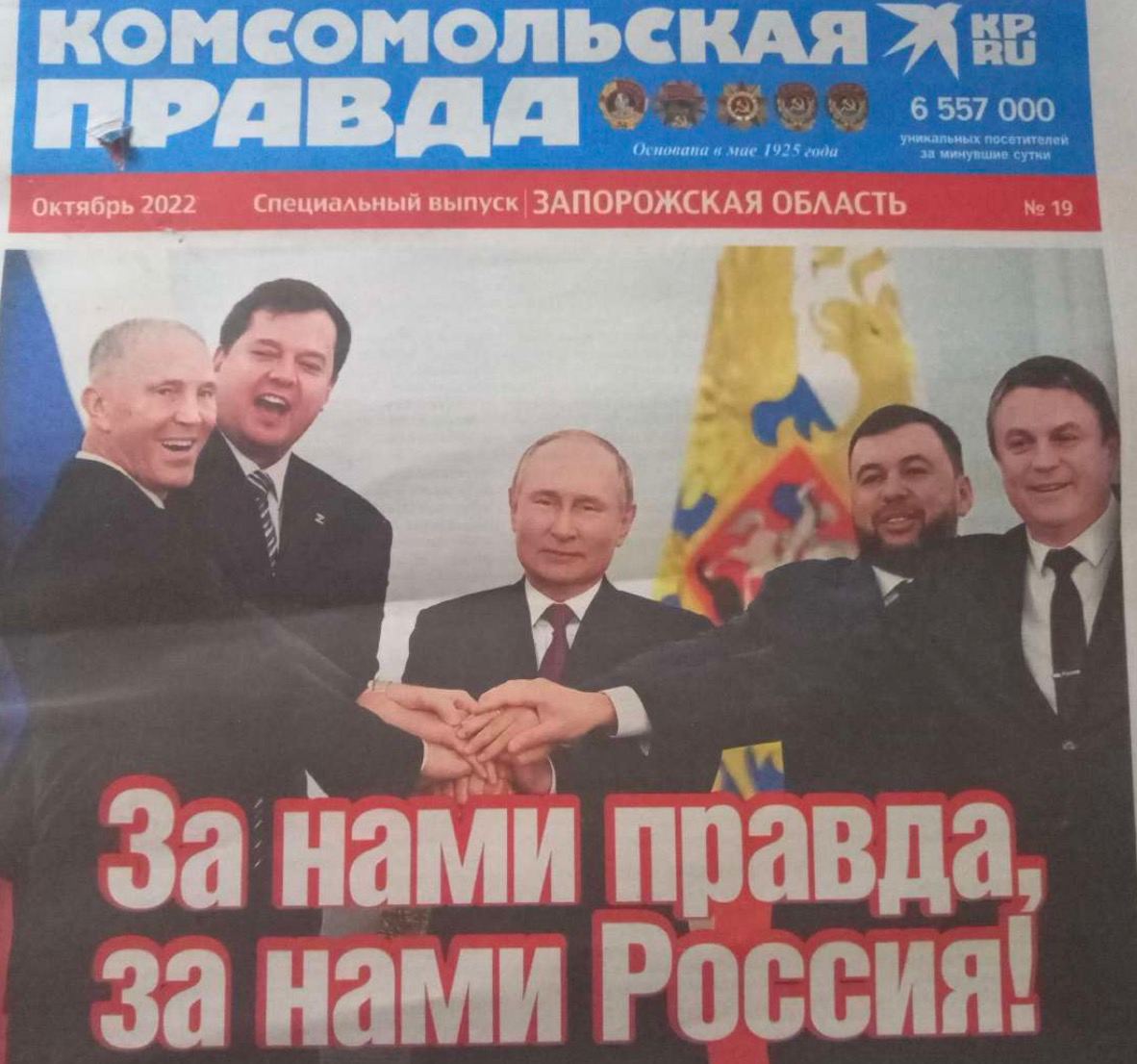
All propaganda newspapers inevitably feature the speeches and statements by Russian President Vladimir Putin, wherein he says the invasion of Ukraine was justified, as it was necessary to “liberate the Donbas from the neo-Nazi regime that has seized power in Ukraine.” A “Boevaya Gazeta” issue dated September 30, 2022 includes a transcript of the President’s address where he mentions the mythical “Nazis” and “neo-Nazis”, who have allegedly seized power in Ukraine, 11 times.
The idea of neo-Nazis in Ukraine is being spread by Russian propaganda – it is one of the many fakes created by the Kremlin. After all, there are no facts to support it. First, fascist ideology is legally banned in Ukraine, and far-right parties are not popular with the citizens. This, in particular, is shown by the 2019 presidential election: the only candidate nominated by Ukrainian nationalist and radicalist organizations won 1.5% of the vote. Nationalist parties got a similar result in the 2019 parliamentary elections, getting 2.15% of the vote, which was not enough to be represented in the Verkhovna Rada of Ukraine.
In the July 21, 2022 edition of “Naddnepryanskaya Pravda”, propagandists argue that the invasion of Ukraine happened because Ukraine had to be denazified and “debunk” the idea that there is no Nazism in Ukraine. In the article entitled “The NAZIonal idea as a path into abyss”, Russian propagandists list the Ukrainian right-wing radical organizations, claiming that “there are not just a few of them, but a whole legion.” The authors of the article do not provide any quantitative and qualitative indicators that would substantiate this claim.

Indeed, there are radicalist organizations in various regions of Ukraine. However, they are small in number and popularity. Similar organizations exist and operate in the Russian Federation as well.
“They do exist, but there are at least as many far-right groups in Russia as there are in Ukraine,” says Ulrich Schmid, a St. Gallen University (Switzerland) professor who specializes in right-wing movements in Eastern Europe.
On July 2, The New York Times published Charlie Smart’s article “How the Russian Media Spread False Claims About Ukrainian Nazis“. The journalist found out that on February 24, the day of Russia’s large-scale attack on Ukraine, the number of Russian mass media articles about “Ukrainian Nazis” increased tenfold – from about 50 per day on average to over 2,000.

Furthermore, for some reason, the Russians decided to enhance the article about “Ukrainian neo-Nazis” with a photo of the Russian imperial movement. In the photo, you can see a black-yellow-white flag – the flag of the Russian Empire, which is used by members of the Russian imperial movement, i.e. far-right nationalists. Next to it is a Celtic cross on black, which is a symbol associated with Nazism.
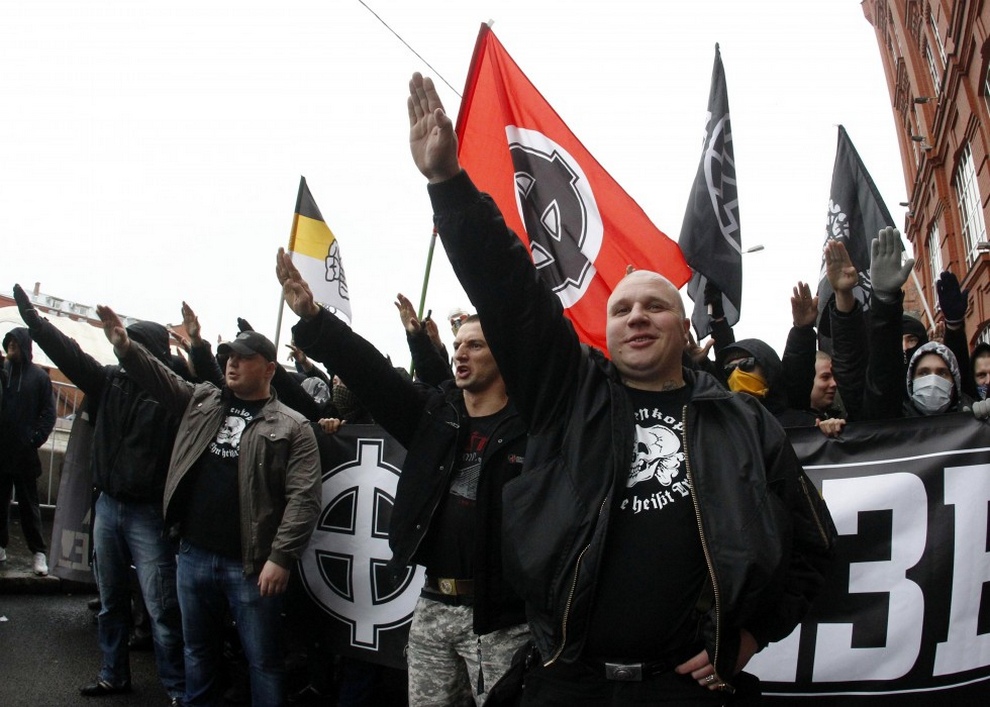
This particular photo was taken during a “Russian March” demonstration in Moscow on the National Unity Day (November 4, 2012). Russia celebrates National Unity Day on November 4, when it commemorates the victory over the Polish invaders in 1612. Photo by Mikhail Voskresensky, Reuters.
Essentially, by promoting the fake about “Ukrainian Nazism”, Russian propagandists are explaining the reason for the attack on Ukraine to Russians while at the same time making sure that the Russian sociery is supportive of the war. Equating the Ukrainian people with Nazis allows Russians to justify the numerous crimes they committed against Ukrainians. This and other narratives ensure that Russians have a lasting perception of the Russian Federation as a defender of “truth” who stands on the side of good and has the moral right to commit terror against those it considers evil.
To explain the need for mobilization in Russia, Vladimir Putin says that the war was needed to “protect the sovereignty and security of Russia’s territorial integrity.” Let us remind you that it was Russia that invaded Ukraine on February 24, 2022, and is killing Ukrainians, engaging in nuclear blackmail, has seized the Zaporizhzhia NPP, fires cruise missiles at cities, destroys the energy infrastructure, leaving millions of Ukrainians without power or heating.
In general, one can say that the task of producing and distributing the occupation press was performed poorly and ineffectively. The newspapers, include almost no actual local context, or any issues and topics that the population would actually have interest in. There are almost no comments or statements by the so-called Gauleiters from among local collaborators. Most of the articles repeat one another and appear to have been created in a centralized manner. Almost every single newspaper had a Putin on the cover. And, as a result, the propaganda tropes which the occupation media were counting on proved useless. People in Snigurivka and Kherson met the Ukrainian defenders with flags and open arms.
The contents of the newspapers found in the temporarily occupied territories are available here.
Kateryna Sereda and Oleh Derenyuha, NikVesti
The article was written together within the “Fight For Facts!” project, which is funded by the German Federal Ministry for Economic Cooperation and Development (BMZ). The views expressed in these articles are those of the independent authors and do not necessarily reflect the views of the BMZ.


